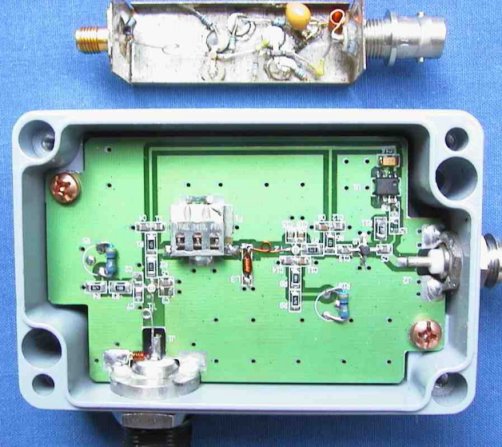
Last updated 2002-12-22
I tried three different preamplifier designs
1st: Rainer Bertelsmeier
His design was published in DUBUS. I never could successfully put it to work ( no gain, no output ), although I tried two specimen of it ( and of course all DC-levels were ok ). In consequence I gave up.
2nd: Matjaz Vidmar
Matjaz's design has been published in UKW-Berichte: Vidmar, M: Ein sehr rauscharmer Antennenverstarker fur das L-Band ( -- a very low noise antennaamplifier for the L-band -- ) UKW-Berichte 3/1991 -- ( also in VHF-Communications 2/92 ). You will find schematic, drawing of construction and pictures here. L2 is one turn of 0.6 mm silvered copperwire, inner diam. 3.5 mm. L3, L4 and L5 are component leads of respective capacitors bent to about 1/2 turn. Adjust souce resistors to result in 10 to 15 mA drain current. Source - drain voltage >= 4 V kills GaAsFETs. A kit is still available from UKW-Berichte, although not on their web pages ( about 40,- Euro ) -- They do have other items also, not found on their pages i.e. an 60cm aluminium prime focus dish for a good price, do not hesitate to ask them .
Advantages of Matjaz's design are:
- very easy and reliable to construct, no oscillations
- low noise
- operates even with course alignment
Matjaz Vidmar's design of a low noise preamp ( the original, unmodified version ).

Meanwhile I built 3 specimens of this amplifier, all of them working equally well. One of them is for more of 5 years in use at an outside installation for Meteosat HRI and APT image reception. The other two are used for experimenting with various antennas and trials to make the input stage lower noisy and/or less susceptible to interference.
A disadvantage could be that it is broadband. I had a period if interfering signals during HRPT image capturing , whose origin could not be identified, in spring this year using this amplifier.Although I searched the spectrum from 0 to 1.8 GHz at the output of the preamp with an spectrum analyzer I did not find any out of band signals. My assumption is that the interfering signals came from an 1.800 GHz GSM basestation nearby. These signals may have led to blocking of the input stage.
3rd: Sam Elsdon (RIG)
Due to the interfering signals described above, I looked for an preamplifier design not so broadband and orderd a kit of the HRPT preamplifier from RIG-Shop . The kit comes complete with all parts, a weatherproof housing included. Construction is easy, alignment not so, since there are tendencies to oscillate, may be due to the high gain of the amplifier.
On top Vidmar's preamp, below Sam Elsdon's design as sold by
RIG shop, to compare physical dimensions.

I tested the new amplifier while installing an other feed to my offset dish antenna with success. A plenty of gain and reasonable noise performance and best of all ( as it seemed ) no blocking, no interference...
...but as it goes, while testing still another feed I gave my loved Vidmar preamp a new try and surprise, surprise no interference, no blocking too. I still do not know what really happened but assume, that the source of interference has disappeared and I do not need countermeasures anymore ( so far, but I am prepared now ).
Progress since:
Just trying to make things better ( that's what mankind always does ), I exchanged the front end GaAs-FET MGF1302 by an HEMT MGF4919 in one of my Vidmar's preamps. After adjusting source resistor to about 9 Ohm for a source-drain current of about 15 mA and drain-load resistor to 470 Ohm to give an appropriate voltage drop, this preamp performed very !! much better. One problem remained, there was a tendency now for oscillations. So I put an additional chip resistor of 25 Ohm between drain and L3. Now it was stable again.
Following this big success I tried the same procedure with my Elsdon ( RIG ) preamp. And surprisingly this preamp perfomed very !! much better too and equals the Vidmar preamp in performance now.
So if you have access to an MGF4919 ( price abt. 3,- Euro ), give it a try !